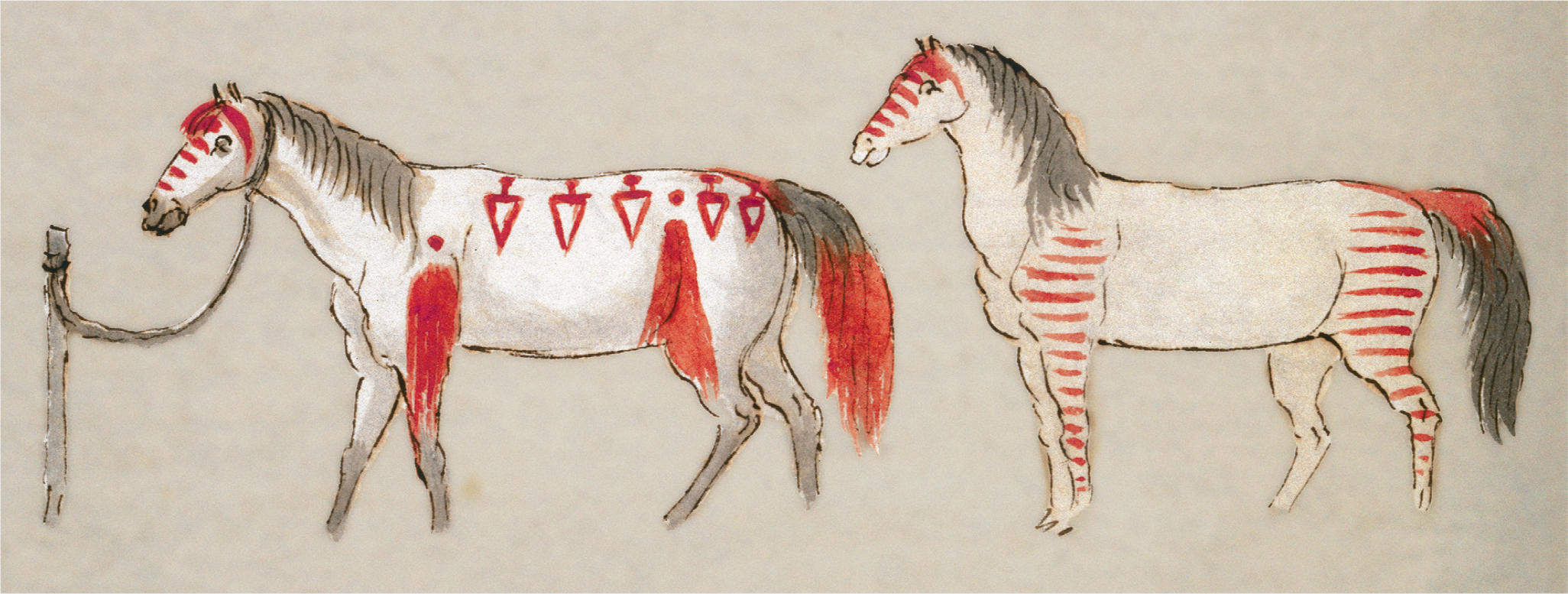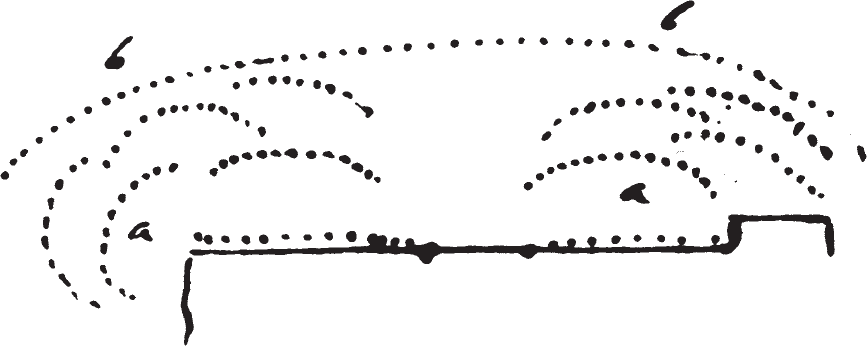August 10th, 1833
10 August: Today it is exactly four months since we left St. Louis. In the morning we had rain [and a] dreary sky, but [it was] not cold. At 7:30, 66°F [18.9°C]. Preparations are being made for trade with the Indians. The chiefs were in the fort off and on. In the afternoon the flag was raised. Two cannon were pulled into the center of the courtyard and loaded; with them were two men with burning fuses. Finally one cannon was fired as a signal to indicate to the Indians that they could now make their visit [and] commence trading. A half hour probably passed before there was noise in the Indian camp. One heard singing and shooting and saw the throng of Indians advancing from all sides. When Spotted Elk (la Biche Caïe) reached the gate, it was opened. Two cannon shots welcomed them, and three or four chiefs of the Piegans who usually lived here approached Mr. Mitchell with bowed heads, one after another, and extended their hands to him, whereupon they were led into our mess hall, where they took their places. Soon another band approached; Mr. Mitchell walked toward them before the gate. They advanced in pelotons [platoons], the chiefs at the head; the [chiefs] always gave Mr. Mitchell some gifts—several beaver pelts and occasionally also a horse. The first horses he received were white ones and a dun, painted in various ways with red dye. The chiefs then entered the fort, where they were received with two cannon shots. After buffalo hides had been spread on the ground [Mr. McKenzie] had them sit down all around the mess hall.  About thirty of the foremost warriors also came in with them and sat down on buffalo hides in a long, interesting row before our building. Three or four bands advanced in this fashion, at a rapid pace amidst heavy firing and chanting; I went with Mr. Mitchell to meet them and was most delighted with this interesting sight.
About thirty of the foremost warriors also came in with them and sat down on buffalo hides in a long, interesting row before our building. Three or four bands advanced in this fashion, at a rapid pace amidst heavy firing and chanting; I went with Mr. Mitchell to meet them and was most delighted with this interesting sight.
One saw the interesting, characteristically Indian physiognomies painted in every possible way, beautifully adorned, and in martial attire. Unfortunately, most of the chiefs wore uniforms acquired from the whites and round hats decorated with plumes and encircled with tin bands, like our German postillions, which considerably distort their appearance. Spotted Elk wore an old green overcoat made from a woolen blanket with red lapels and collar; [his] hat [was] round, with plumes; his plain Piegan hair [was] hanging down; and his face [was] painted vermilion. Other chiefs had blue or red uniforms—indeed, even half red and half green, like carnival jesters—nothing but clothing given them as gifts by the Europeans. La Chemise-de-Fer [Iron Shirt] had the most interesting dress in the Indian style: his face, coal-black; his eyes, mouth, and two stripes running vertically down temples and cheeks, vermilion.
When the Piegan bands, three or four in number, had marched here from their camp and were welcomed, a band of the Blood Indians, Kaë́nna, also came marching in, headed by their chief (medicine man), Natohs,M6The same chief, Sun, was also called Dry Meat, Kaïä́hs, and Achkotóhmachkann (‘ch’ velar), that is, roughly, Several Who Run Together. [and] presented gifts; the chiefs sat down in the fort.[Page 2:225] After them appeared a peloton of about sixty to eighty warriors of the Gros Ventres des Prairies , who likewise presented a horse and beaver pelts, and some of them were admitted. Each time they were welcomed with cannon shots, and then some of them handed over flags [they had] acquired from the English, which they had carried in wholly military fashion on long poles in front of them. Mr. Mitchell had wanted to dispense with the petty formalities and the welcoming cannonade last year, but the Indians seemed to place great value upon [these things] and even wanted to withdraw if sufficient honors were not bestowed upon them.
When all the chiefs, about nine, [and] the foremost warriors, about thirty, had taken their places in the fort, whiskey was passed around and they smoked their pipes. Meanwhile, Mr. Mitchell took Spotted Elk aside and presented him with a completely new, half red and half green coat, with green and red shoulder straps and lapels with silver braid; a hat of red felt, with many plumes and variously decorated; a new, double-barreled percussion gun—all in all a complete outfit. This chief had always shown himself to be loyal to the American Fur Company and had never gone to trade [with] the English posts in the North, for which reason [the company] wanted to show him special honor. When he was dressed, he stepped into the courtyard. One could observe the unpleasant impression that his splendid attire (worth 150 dollars) made [on] the other chiefs in the room. Several chiefs, who had given gifts to Mr. Mitchell and not yet received anything in return, especially la Chemise-de-Fer [Iron Shirt] and several others, could not conceal their feelings. The former hid his head behind his neighbor; others lowered their heads and seemed to be lost in contemplation. Mr. Mitchell had them told: they could see that the American Fur Company knew how to treat its friends with distinction. Could anyone say that they had ever received such fine clothes from the English? Some of them had gone to trade with the English and had sold them their beaver skins; for this reason he could not give them big gifts. But he would give every chief a present. In the future let them behave like Spotted Elk [and] then he could give them big gifts too. M7Later they had the newly clad chief mount his white horse and ride around outside the fort between the semicircles of seated Indians to show himself off, [whereupon] he delivered a long speech, rode into the camp, returned, and dismounted again. Spotted Elk was not popular; his situation was dangerous. He sat there like an outcast with bowed head and finally went into Mr. Mitchell’s room to separate himself from the others.
The chiefs [then] began making vehement speeches. The interpreter was not good, something that certainly contributed even more to the misunderstanding. When the whiskey, too, had already had some effect, several stood up, including a fat old manM8He is a chief, and formerly his name was Old Head (la Vielle Tête; Otokuan-Nepó). Now he is called Stiff Foot (Haiesikate—[each] ‘e’ barely audible). [who,] with the most interesting [and] vigorous gesticulations, delivered a long speech in the courtyard of the fort. He said to Spotted Elk, standing on the side, “Do not drink so much whiskey! That is my advice to you. And go home!” Because he was the chief’s brother-in-law, that was to be regarded as good advice. The Blood Indians were offended. They talked about shooting Spotted Elk to death. The latter’s friends and relatives came to him and conferred intently with him. In the meantime, one saw all the other Indians seated in semicircles before the gate of the fort. They sat on the ground, sang incessantly, [and] occasionally fired off their guns, and whiskey mixed with water was brought to them.
The Blood Indians were offended. They talked about shooting Spotted Elk to death. The latter’s friends and relatives came to him and conferred intently with him. In the meantime, one saw all the other Indians seated in semicircles before the gate of the fort. They sat on the ground, sang incessantly, [and] occasionally fired off their guns, and whiskey mixed with water was brought to them.
These opening ceremonies and entrance visits lasted until almost six o’clock, when the chiefs left and then returned again with little whiskey kegs, which were filled for them as presents. Trading now began. They brought their beaver pelts, buffalo blankets, and other objects. Whiskey, their idol, was always the main thing for which they traded. [Next,] a tumultuous scene began. Our French engagés, who had drunk too much whiskey, began fighting. There were bloody noses. Harvey, the clerk, intervened [and] became involved in the fight; [he] struck someone on the head with his tomahawk after he had been struck, and the fight became very serious.[Page 2:226] This set a bad example for the Indians, who had conducted themselves better and were standing there as quiet spectators.
After this unpleasant matter had finally been stopped, we witnessed the most interesting, comical scenes. The Indians, some of whom had drunk too much whiskey, became extremely affectionate. There was no end of hand shaking, and they came up to us to embrace and kiss us cordially. They traded their hides for whiskey [and] begged continually for whiskey from all of us. A tall Indian, Big Soldier, HaschástoM9The French call him le Gros-Soldat [Big Soldier], but his name is Orator (le Harangueur), Haschásto. (according to my measurement, 5 feet 10 inches 2 lines [Paris measure] tall; but [he] did not enjoy very high esteem among his countrymen), was supposed to be sketched by Mr. Bodmer and hence had sat all day long in our room. He had the most beautiful costume we had yet seen here, completely decorated on the sleeves with strips of white ermine fur; he, too, wanted whiskey and became discontented. Nevertheless, there were no quarrels among the Indians in the fort. But Spotted Elk drove all his horses, seventeen in number, into the fort for the night, where they also remained the following day for safety’s sake. Trading lasted until far into the night, and several of the Indians came to blows. Very amusing was a scene with an old, half-decrepit Indian, painted gray, who brought a very tame, live she-bear into the fort to sell. He sat down on the ground with his pet [and] played [with] and kissed it repeatedly. The animal was very delightful, completely tame, and I bought it on the following day for whiskey. Mr. Mitchell gave me a beautiful little male as well.


